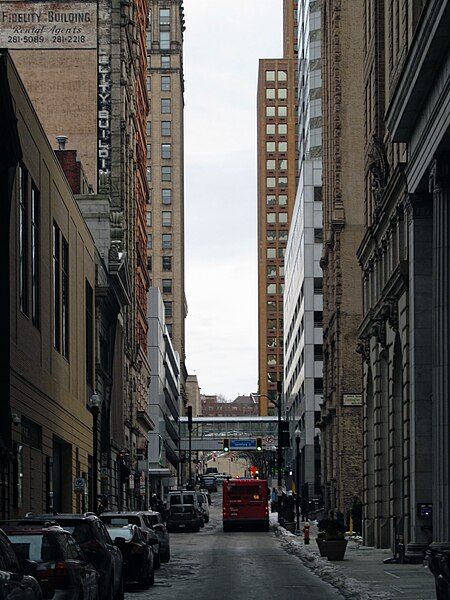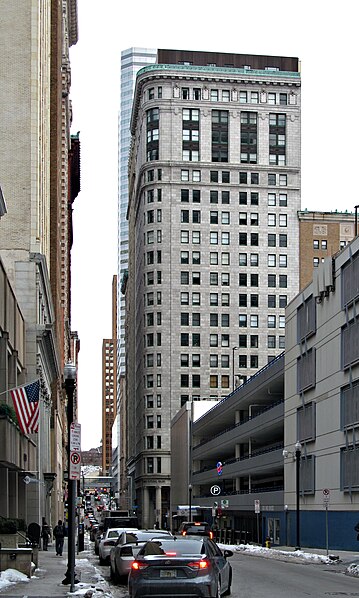
Looking eastward on Fourth Avenue from the intersection with Wood Street.

Now converted to luxury apartments as “The Carlyle,” this classical Fourth Avenue bank tower was designed by the firm of MacClure and Spahr. Benno Janssen, who was working at the firm, is said to have had a large part in the design. It opened in 1906. Curiously, the building behind it, the Commonwealth Bank Building, was built at the same time and reached exactly the same height, 300 feet.

John Massey Rhind was Andrew Carnegie’s favorite sculptor; he gave us the Noble Quartet in front of the Carnegie Institute and the statue of Robert Burns outside Phipps Conservatory. Here he gives us some allegorical figures to adorn the entrances to the People’s Savings Bank’s splendid tower at Fourth Avenue and Wood Street. Not altogether coincidentally, the building itself was designed by Alden & Harlow, Carnegie’s favorite architects, whose firm (with their earlier partner Longfellow) was also responsible for the Carnegie Institute. Above, the Wood Street side; below, the Fourth Avenue side.


This building sits in what may be the densest block of great architecture in North America, and no one pays attention to it. It is not mentioned in the various guides to Fourth Avenue, so old Pa Pitt does not know the architect or whether the building even has a name. When the building was put up, it was apparently at 93 and 95, according to the numbers over the doors; but its address is now 311 Fourth Avenue. A classified ad in the Dispatch from 1890 mentions the firm of Black & Baird as lending money at 95 Fourth Avenue. The National Real Estate Journal in 1922 shows 311 as the home of the Freehold Real Estate Co.; if the address numbers had changed by then, this is that building.
As a work of architecture, the only thing that can be said against it is that it does not compete with the works of Daniel Burnham, Alden & Harlow, Frederick Osterling, and the other great names whose works line this street. If it is a work of one of those masters, then it is a lesser work—but certainly not one to be ashamed of. In any other block it would be one of the more distinguished buildings. The large windows on the second and third floors suggest workshops of some kind. The ornamentation is artistic and in exactly the right proportion to accent rather than unbalance the architectural forms.
Any readers who know more about the origin and history of this building are earnestly invited to comment.

In his earlier career, Frederick Osterling carved out a niche for himself providing Richardsonian Romanesque buildings for people who couldn’t get Richardson (because Richardson was dead). The Allegheny County Courthouse created a mania for the style in Pittsburgh, and Osterling seems to have had all the work he could handle. In this building from 1892, we see the hallmarks of Osterling’s own variation on the style. He was more florid than Richardson, but he was always aware of the overall composition, never allowing the numerous individual details to break up the carefully orchestrated rhythm of the façade.
Below, we see the Times Building in context, with One Oxford Centre looming in the middle distance.
